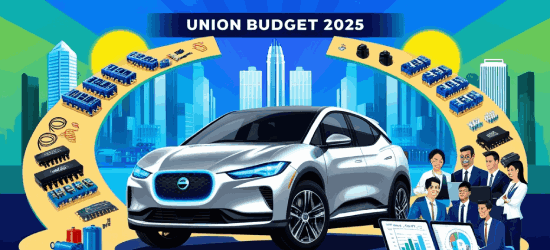Union Budget 2025: EV and battery manufacturers get a major boost

By Team Indoen
Posted on 01 Feb 2025
The latest budget presented in the
Parliament by the Hon’ble Union Minister Nirmala Sitharaman appears to be a
promising one, at least for the electric vehicles (EV) manufacturers and the
energy sector overall. The government has introduced some crucial measures
which are expected to encourage manufacturers of EVs, batteries, and import and
recycling of critical materials.
Presenting the budget, the Hon’ble Minister
Sitharaman said that the government plans to set up a National
Manufacturing Mission (NMM) covering small, medium and large industries.
The NMM will be crucial in terms of policy support, execution of roadmaps, and
providing a governance and monitoring framework for central and state
ministries.
The government’s move to exempt cobalt
powder, lithium-ion battery waste and scrap, lead, zinc, and 12 other critical
minerals may bode well for the EV industry; it is a right direction towards
building homegrown products, say analysts. Manufacturers, especially the micro,
small and medium enterprises (MSMEs) would benefit from this initiative,
according to them.
NMM will help the production of solar PV
cells, EV batteries, motors and controllers, electrolysers, wind turbines,
high-voltage transmission equipment, as well as grid-scale batteries. India can
upgrade its self-reliance in clean energy and electric mobility.
To buttress this effort, the central
government has allocated Rs. 410 crore for the NMM in its 2025-26 budget. Further,
the budget allocation for PLI scheme under the National Programme on Advanced
Chemistry Cell (ACC) Battery Storage gets an (over ten times hike) from Rs.
15.42 crore to 155.76 crore.
Giving thumbs up to the government’s
endeavors to curb imports, analysts have opined that the move will help reduce
costs and promote sustainable growth and strengthen India’s circular economy. It
will also enhance the competitiveness of domestic firms besides create jobs.
However, the success of this planned initiative rests upon how effectively the
ambitious programme will be implemented, how infrastructure development is
carried out and the establishment of a healthy collaboration between public and
private entities which will be crucial.
Tabling the budget, the minister said that
a policy for recovery of critical minerals from tailings will be brought out.
Keeping in view the fact that the process and technology for recovery of
critical minerals would be cost intensive, it would be great if the proposed
policy can include the financial aspects of the recovery process besides
providing monetary assistance to businesses for establishing recovery units.
The customs duty exemption on cobalt, one
of the costlier battery metals, will facilitate lithium-ion battery
manufacturing, which is crucial for EVs. The NMM coupled with the PLI scheme
and FAME II scheme would help EV manufacturing and demand.
Also, there is an increase in Prime
Minister Electric Drive Revolution in Innovative Vehicle Enhancement
(PME-DRIVE) scheme with a significant hike from Rs 1,870.76 crore in 2024-25 to
Rs 4,000 crore in 2025-26. Similarly, the increase in budget for the PLI scheme
for automobiles and auto components from Rs 346.87 crore in 2024-25 to Rs
2,818.85 crore in 2025-26 will be of great support.
The government proposes to add 35
additional capital goods for EV battery manufacturing which will boost domestic
manufacture of lithium-ion battery, a critical component in manufacture of EVs.
Tax exemptions for lithium-ion battery
manufacturing would help strengthen domestic manufacturing capabilities, and
perhaps position India as a global leader in EV manufacturing. This goes well
with India’s broader objectives of curbing carbon emissions and gaining
self-reliance in energy besides meeting the climate goals.
As per the government, the mission will
support clean tech manufacturing, improve domestic value addition and build an
ecosystem for solar PV cells, EV batteries, motors and controllers,
electrolyzers, wind turbines, very high voltage transmission equipment and grid
scale batteries.
The centre also plans to incentivize
electricity distribution reforms and augment intra-state transmission capacity
by states to improve the financial health and capacity of electricity
companies. An additional borrowing of 0.5% of gross state domestic product
(GSDP) will be allowed to states, contingent on these reforms, these measures
will be crucial in uplifting the power sector.
Mission 2047 is talked about in various
forums for which energy transition is vital including the development of 100
gigawatt of nuclear energy by that period. To augment this, government proposes
amendments to the Atomic Energy Act and the Civil Liability for Nuclear Damage
Act. A Nuclear Energy Mission for research and development of small modular
reactors (SMR) with an outlay of about Rs. 20,000 crore will be set up and at
least five homegrown SMRs will start operations by 2033.
Overall, the Union Budget 2025-26 presents
a promising outlook for the energy sector, with some important strategic
measures to boost the domestic production of EVs, expansion of solar PV cell
production, and implementation of electricity distribution reforms. By
promoting clean technologies and incentivizing sustainable practices, the
government is reinforcing its commitment to energy security, environmental
sustainability, and a low-carbon future.
India is a signatory to the Paris agreement
and initiatives such as these are expected to support the country’s clean
energy transition and strengthen its position as a global leader in green
technology innovations.
- India’s climate finance blueprint: A snail’s pace or a fast gallop?
- Strategic Pathways For India’s Green Mobility
- India’s green hydrogen mission: Powering a sustainable future
- India to cap investment in EV charging for tariff relief as Tesla entry...
- Centre likely to modify new EV policy as Tesla gears up to enter India
- India's EV push needs high-speed trains ... China's adoption rate
- India's EV incentive plan finds no takers-government weighs fix
- Why Tesla’s entry is unlikely to disrupt India’s retail EV market
- Scaling up e-mobility in India hinges on private investment and policy reforms, say experts
- India needs 39 lakh charging stations by 2030: report